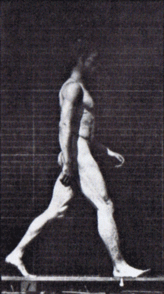步行

步行,是有腿動物進行動物運動的主要步態之一,通常比跑步和其他步態慢。步行被定義為一種「倒單擺」的步態。在這種步態中,每走一步上身體都要拱起腳才能前進。步行不分肢的數量,即使是有超過一對足的節肢動物也可以步行。[1]人類的步行有時也定義為隨時保持一隻腳在地上的移動方式,若兩腳同時離地則稱為跑步或跳躍。
起源[编辑]
根據理論,四足動物之間的“行走”源於水下。例如蝟鰩(Leucoraja erinacea),是底層區魚類群落的一員,可以用它們的腹鰭以推離海底。早在4.2億年前,它們就進化出特有的神經機制以推動自己前進,這比脊椎動物踏上陸地要早[2][3]。呼吸空氣的魚類在水下用鰭“行走”,隨後產生像提塔利克魚屬這樣可以上陸的脊椎動物[4],之後再進化出生活在陸地上靠四肢行走的生物[5]。陸生四足動物理論上只有一個起源,四肢演化自魚鰭,而節肢動物和它們的近親,特別是在昆蟲、多足綱動物、螯蝦、緩步動物、甲狀旁腺動物和甲殼類動物,已被認為曾多次獨立進化了行走[6]。
鳥類、大穿山甲、人類、以及一些肉食性恐龍獨立演化出二足步行,有些蜥蜴在高速跑步時也只用二足,袋鼠和跳鼠用二足跳躍移動。目前認為人類的二足步行始於約400萬年前的南猿。從肯尼亞古海岸發現的腳印來看,人們認為在150萬年前現代人類的祖先很可能以與現在非常相似的方式行走[7][8]。
在不同動物中[编辑]
人類[编辑]

人類通過「雙擺」的策略而完成步行。在向前運動期間,腿離開地面從臀部向前擺動,這是第一次擺動。之後腿部隨腳跟撞擊地面,並以「倒單擺」的動作滾動到腳趾,這是第二次擺動。[9]由於兩條腿的運動協調一致,因此一隻腳或另一隻腳始終與地面接觸。通過利用鍾擺力和地面反作用力,步行過程中可節省約40%的能量。[10]
對人類而言,大多數嬰兒在九到十六個月間開始學走[11],而平均老年人步行的速度是3.2 km/h ~ 3.9 km/h,年輕人則為3.75 km/h ~ 5.43 km/h[12][13]。
馬[编辑]

馬的步態為四拍式步態,平均每小時行約6.4公里。步行時,馬的腿以「左後腿-左前腿-右後腿-右前腿」的順序、以規則的1-2-3-4節拍運動。步行時,除非將重量從一隻腳轉移到另一隻腳,馬總是將一隻腳抬起,另一隻腳放在地上。馬的頭部和頸部略微上下運動,以協助保持平衡。[14]
大象[编辑]

大象可以前後移動,但不能小跑、跳躍或飛奔。在陸地上行走時,牠們只使用兩種步態:步行和類似於跑步的更快步態。[15]大象步行時,腿像擺錘一樣;象腳放在地上時,臀部和肩部會上升或下降。[16]快速移動的大象似乎用前腿“跑”,但用後腿“行走”。儘管大象快速移動時的姿態很像其他奔跑的動物,由於沒有“空中階段”,大象仍為步行狀態。大象快速移動時可達約18公里/小時的最高速度。[17]
對健康的影響[编辑]

如可以持久的每周五天、每天走路三十至六十分鐘,再加上正確的姿勢走路的話,身體會更健康[19][20]。定期步行可以提高自信、耐力、精力、減肥能力和預期壽命,並減輕精神壓力。[21][22][23]亦有研究表明步行可以降低發作冠心病、中風、糖尿病、高血壓、腸癌和骨質疏鬆症的風險。[24]有研究表明,步行除了具有身體上的益處外亦對大腦有益,可以提高記憶力,學習能力,專注力和抽象推理程度[25][26]。長期步行的人癌症和心臟病的機會可稍微降低,而壽命也會有所增加。步行還會令骨骼更加健康,特別是胯骨,另外還可降低低密度脂蛋白,並增加高密度脂蛋白[27]。
參見[编辑]
- 可步行性 - 衡量對步行的友好程度的指標
參考資料[编辑]
- ^ Cavagna GA, Heglund NC, Taylor CR. Mechanical work in terrestrial locomotion: two basic mechanisms for minimizing energy expenditure.. American Journal of Physiology. 1977, 233 (5): R243–261. doi:10.1152/ajpregu.1977.233.5.R243.
- ^ H. Jung et al. The ancient origins of neural substrates for land walking. (页面存档备份,存于互联网档案馆) Cell. Vol. 172, 2018-02-08, p. 667. doi:10.1016/j.cell.2018.01.013
- ^ Garisto, Dan, The wiring for walking developed long before fish left the sea (页面存档备份,存于互联网档案馆) . Science News . 2018-02-08
- ^ Choi, Charles. Hopping fish suggests walking originated underwater; Discovery might redraw the evolutionary route scientists think life took from water to land. NBC News. 2011-12-12 [2012-08-22]. (原始内容存档于2020-09-10).
- ^ What has the head of a crocodile and the gills of a fish?. evolution.berkeley.edu. [2018-06-06]. (原始内容存档于2019-04-24).
- ^ Grimaldi, David; Engel, Michael S.; Engel, Michael S. Evolution of the Insects – David Grimaldi, Michael S. Engel – Google Books. 2005-05-16 [2018-06-11]. ISBN 9780521821490. (原始内容存档于2020-09-10).
- ^ Dunham, Will. Footprints show human ancestor with modern stride. Reuters. 2009-02-26 [2009-08]. (原始内容存档于2021-03-14).
- ^ Harmon, Katherine. Researchers Uncover 1.5 Million-Year-Old Footprints. Scientific American. 2009-02-26 [2009-08].
- ^ Uyar, Erol; Baser, Özgün; Baci, Recep; Özçivici, Engin. Investigation of Bipedal Human Gait Dynamics and Knee Motion Control (PDF). Izmir, Turkey: Dokuz Eylül University – Faculty of Engineering Department of Mechanical Engineering. 2002-10 [2009-08-01]. (原始内容 (PDF)存档于2012-05-28).
- ^ Walk without waste. ABC Online Index. 2001-01 [2009-08]. (原始内容存档于2021-03-09).
- ^ Samra HA, Specker B. Walking age does not explain term versus preterm difference in bone geometry. J Pediatr. July 2007, 151 (1): 61–6, 66.e1–2. PMC 2031218
 . PMID 17586192. doi:10.1016/j.jpeds.2007.02.033.
. PMID 17586192. doi:10.1016/j.jpeds.2007.02.033.
- ^ Study Compares Older and Younger Pedestrian Walking Speeds. TranSafety, Inc. 1997-10-01 [2009-08-24]. (原始内容存档于2009-07-03).
- ^ Aspelin, Karen. Establishing Pedestrian Walking Speeds (PDF). Portland State University. 2005-05-25 [2009-08-24]. (原始内容存档 (PDF)于2021-03-14).
- ^ Harris, Susan E. Horse Gaits, Balance and Movement New York: Howell Book House 1993 ISBN 0-87605-955-8 pp. 32–33
- ^ Shoshani, J.; Walter, R. C.; Abraha, M.; Berhe, S.; Tassy, P.; Sanders, W. J.; Marchant, G. H.; Libsekal, Y.; Ghirmai, T.; Zinner, D. A proboscidean from the late Oligocene of Eritrea, a "missing link" between early Elephantiformes and Elephantimorpha, and biogeographic implications. Proceedings of the National Academy of Sciences. 2006, 103 (46): 17296–301. Bibcode:2006PNAS..10317296S. PMC 1859925
 . PMID 17085582. doi:10.1073/pnas.0603689103.
. PMID 17085582. doi:10.1073/pnas.0603689103.
- ^ Hutchinson, J. R.; Schwerda, D.; Famini, D. J.; Dale, R. H.; Fischer, M. S. & Kram, R. The locomotor kinematics of Asian and African elephants: changes with speed and size. Journal of Experimental Biology. 2006, 209 (19): 3812–27. PMID 16985198. doi:10.1242/jeb.02443
 .
.
- ^ Genin, J. J.; Willems, P. A.; Cavagna, G. A.; Lair, R. & Heglund, N. C. Biomechanics of locomotion in Asian elephants. Journal of Experimental Biology. 2010, 213 (5): 694–706. PMID 20154184. doi:10.1242/jeb.035436
 .
.
- ^ Balish, Chris. How to live well without owning a car. Ten Speed Press. 2006: 134. ISBN 1580087574. (Google books)
- ^ Mayo Clinic - Proper walking technique (页面存档备份,存于互联网档案馆)
- ^ Community Development Department, City of Cambridge, Massachusetts - The Health Benefits of Walking 互联网档案馆的存檔,存档日期2012-05-02.
- ^ Boone, Tommy. Benefits of Walking. HowStuffWorks. [2009-09]. (原始内容存档于2010-03-28).
- ^ Walking for fitness: How to trim your waistline, improve your health. Mayo Clinic. [September 2009]. (原始内容存档于2019-07-30).
- ^ Crawford, Deborah. Why Walking is the Most-recommended Exercise. BellaOnline. [September 2009]. (原始内容存档于2017-07-02).
- ^ Brown, Marie Annette; Robinson, Jo. When your body gets the blues: the clinically proven program for women who feel tired and stressed and eat too much. Rodale. 2002: 82. ISBN 157954486X.
- ^ Edlin, Gordon; Golanty, Eric. Health and wellness. Jones & Bartlett Publishers. 2007: 156. ISBN 0763741450.
- ^ Tolley, Rodney. Sustainable transport: planning for walking and cycling in urban environments. Woodhead Publishing. 2003: 72. ISBN 1855736144.
- ^ Yeager, Selene; Doherty, Bridget. The Prevention Get Thin Get Young Plan. Rodale. 2000. ISBN 1579542174.
| 维基共享资源上的相关多媒体资源:步行 |
| |||||||||||||||||
